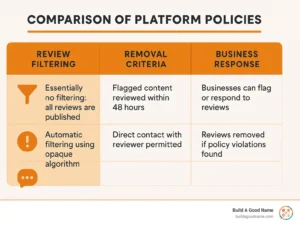Why Business Owners Need to Filter Negative Reviews Wisely
Filter negative reviews is one of the most searched phrases by business owners who’ve just received their first brutal one-star rating. The good news? You have options. The bad news? Most of them can backfire spectacularly if done wrong.
Quick Answer: How to Filter Negative Reviews
- Private feedback routing – Direct low ratings (3 stars or below) to private forms first
- Policy-based removal – Flag reviews that violate platform guidelines (spam, hate speech, off-topic)
- Response strategies – Address genuine complaints publicly and professionally
- Never use review gating – Always provide option to post publicly (required by Google, FTC)
- Focus on volume – Generate more positive reviews to naturally dilute negatives
84% of consumers find online reviews as trustworthy as personal recommendations. One harsh review can cost you an average of 30 customers, while businesses with overwhelmingly positive reviews see customers spend 31% more.
The challenge isn’t just managing bad reviews – it’s doing it ethically and legally. Platforms like Google have strict policies against “review gating” (hiding the option to leave negative feedback). The FTC can fine businesses for deceptive practices.
Research shows that when platforms make their review filtering transparent, review volume drops, but the remaining reviews become more negative and shorter. This creates a dilemma – transparency builds trust but may discourage engagement.
The solution isn’t to hide negative feedback entirely. It’s to filter negative reviews intelligently – routing low ratings to private feedback forms first while always maintaining the option for public posting. Companies using this approach report a 13% increase in leads while staying compliant with platform policies.

Review Filtering 101: Filtering vs Moderating vs Removing
Before we dive into the how-to, let’s get our terminology straight. Business owners often use these terms interchangeably, but each one carries different legal and ethical implications.
Filtering is like being a smart traffic controller for your reviews. You’re creating different pathways based on what customers say. A five-star review might zip straight to your Google listing, while a two-star rating gets routed to a private feedback form first. The customer still has the choice – you’re just offering them a detour to potentially resolve things privately.
Moderating happens after someone submits a review but before it goes live. Most platforms like Google and Yelp handle this automatically using AI that scans for spam, fake reviews, or content that violates their policies.
Removing is the nuclear option – taking down reviews that are already public. This only works when reviews clearly violate platform rules or through legal action for defamation.
Scientific research on moderation transparency found that when platforms are completely transparent about their filtering processes, people actually submit fewer reviews overall, but the ones they do submit tend to be more negative and shorter.
What does it mean to filter negative reviews?
When people search for how to filter negative reviews, they’re usually looking for a way to catch unhappy customers before their frustration goes public. Smart filtering is like having a conversation with someone who’s upset before they start telling everyone else about it.
The most common approach is star-threshold filtering. You set a cutoff point – typically three stars or below – that triggers a different response. Instead of immediately asking them to post publicly, you invite them to share more details privately.
Modern systems also use sentiment analysis to read between the lines. Even a four-star review that says “Great food but terrible service” might get flagged for private follow-up.
But here’s the golden rule: private routing must always include the option to post publicly anyway. That’s the difference between helpful and deceptive.
The Thin Line Between Curation and Censorship
The difference between smart reputation management and getting slapped with FTC fines often comes down to one simple concept: choice.
Ethical filtering expands customer options. Unethical gating eliminates them. The Consumer Review Fairness Act specifically protects customers’ rights to share honest opinions about their experiences, even when those opinions sting.
The FTC guidance is clear: preventing customers from posting negative reviews while encouraging positive ones is considered deceptive. But encouraging all customers to contact you first? That’s just good customer service.
What lands you in trouble is creating two different experiences – one for happy customers (easy public posting) and another for unhappy ones (hidden or difficult public posting). The sweet spot is transparency – be upfront about wanting to resolve issues privately first, but always make it clear that customers have the final say.
Should You Filter Negative Reviews? Ethics, Laws & Consequences
Here’s the million-dollar question: Should I try to filter negative reviews? The honest answer isn’t as simple as yes or no – it’s all about how you do it.
The stakes are real. Get caught using deceptive review practices, and you’re not just looking at a few bad reviews – you could face platform penalties that wipe out your online presence entirely.
Google can remove your business listing. Amazon can suspend your selling privileges. Yelp can flag your business as potentially deceptive. The Federal Trade Commission has been cracking down hard on businesses that manipulate reviews, handing out significant fines.
Scientific research on transparency impact reveals that businesses walking this transparency tightrope face a genuine dilemma. Being completely open about your review filtering actually reduces the total number of reviews you receive, but it increases “authenticity signals” – the markers that tell customers your reviews are genuine.
Perhaps most damaging is what happens when customers figure out you’ve been manipulating your review stream. When that backlash hits, it’s often far worse than whatever negative reviews you were trying to avoid.
Legal Landmines When You Filter Negative Reviews
Google strictly prohibits “review gating” – showing the review option only to happy customers while hiding it from unhappy ones. But Google actually allows you to request feedback privately first, as long as you always provide the public review option too.
Platform takedown procedures exist, but they’re not as helpful as most business owners hope. Google promises decisions within 48 hours for flagged content, but their success rate for removal requests is quite low unless there are obvious policy violations.
The legal landscape gets trickier when you consider the difference between defamation and opinion. You might pursue legal action against reviews containing false statements of fact, but you cannot remove reviews that simply express negative opinions about your service.
The Transparency Effect on User Trust and Engagement
Research comparing over 1,000 restaurants found that when businesses are transparent about their filtering processes, something unexpected happens:
Total review volume drops. Fewer people leave reviews when they know the process is being monitored.
The percentage of negative reviews actually increases. When people know their feedback matters and won’t be hidden, those with genuine complaints are more likely to speak up.
Reviews become shorter on average. Transparent filtering encourages more concise, focused feedback.
This creates a strategic choice: do you want more reviews or fewer reviews that customers actually trust? Most businesses focused on building long-term reputation choose authenticity over volume.
Platform Playbook: How Amazon, Google, Yelp & More Tackle Negatives
Each major platform has developed its own approach to managing negative feedback, and understanding these differences can save you hours of frustration.
Amazon takes the verification route. They focus heavily on confirmed purchases. Sellers can contact reviewers directly through the platform to resolve issues and request review updates. However, accumulate too many negative reviews and Amazon might suspend your selling privileges entirely.
Google plays the AI game. Their system combines artificial intelligence with user flagging to catch problematic content. You can flag reviews through your Google My Business dashboard, and they promise decisions within 48 hours. Google explicitly prohibits political rants and off-topic complaints.
Yelp relies on algorithmic mystery. Their filtering system is sophisticated but only partially transparent. Reviews from users with limited history get automatically hidden. While businesses can’t directly remove reviews, you can flag clear policy violations.
Airbnb offers mediation services. Hosts can dispute reviews containing false information, but you need documented evidence. The platform actually mediates these disputes.
Feefo takes the radical transparency approach. They maintain a strict no-filtering stance where businesses cannot hide negative reviews from public pages.

Detecting Fake vs Genuine Complaints
Platforms are getting scary good at spotting fake reviews. AI spam detection now analyzes everything from writing patterns to the time between account creation and review posting. Google’s improvements alone led to removing 45% more fake reviews in 2023 compared to the previous year.
The algorithms look for telltale signs: reviewer verification through confirmed purchases, pattern recognition that spots multiple reviews with suspiciously similar language, and behavioral analysis that flags users who only leave negative reviews for competitors.
When you find suspicious reviews, don’t just complain about them – use the proper flagging procedures. Document everything and respond to Google reviews professionally while building your case for removal.
When Is Removal Justified?
Clear policy violations are your strongest grounds for removal. This includes hate speech, personal threats, harassment, or content completely unrelated to your business.
Spam and fake content from competitors or paid negative reviewers also violates platform policies. The trick is proving it, which requires documentation and patience.
Personal information breaches happen more often than you’d think. Reviews containing private details must be removed for privacy protection.
Defamatory false statements about illegal activity or other specific claims you can prove wrong are also removable. But you cannot remove reviews simply because they’re negative or critical. Opinions like “the food was terrible” are protected speech, even when they sting.
From Filtering to Fixing: Best Practices to Handle Negative Feedback
The smartest way to filter negative reviews isn’t about hiding them from the world. It’s about turning those painful moments into opportunities that actually strengthen your business.
Every negative review is basically free consulting. Someone took time out of their day to tell you exactly what’s wrong with your business. That’s valuable intel, even when it stings.
Start with your public response game. Every single negative review deserves a professional public reply. Keep your public responses warm but professional. Acknowledge what went wrong specifically rather than giving generic responses. Take responsibility where it makes sense, explain what you’re doing differently now, then invite them to continue the conversation privately.
Here’s a simple framework: “Thanks for sharing your experience with our checkout process, Sarah. You’re absolutely right that waiting 15 minutes wasn’t acceptable. We’ve added two more staff members during peak hours and redesigned our queue system. I’d love to discuss this further – could you email me directly at…”
Private resolution comes next. After your public response, reach out privately to fix their specific problem. The magic happens when you close the feedback loop. Use those negative reviews to spot patterns in your business.
Our automated review replies can help you stay on top of every review with personalized responses that sound authentically like you.
Filter Negative Reviews the Right Way—Private First, Public Option Always
Here’s how to filter negative reviews without getting into trouble with Google or the FTC: create a system that encourages private conversation first, but never takes away the public option.
Set up smart threshold tools. When someone gives you 3 stars or below, your system should automatically present them with a private feedback form first. Most successful businesses use this 3-star cutoff because it catches genuinely unhappy customers while letting satisfied customers (4-5 stars) go straight to public reviews.
The key is in how you present this choice. Instead of hiding the public option, you’re just offering a better path first. Use language like “We’d love to hear more about your experience and see if we can address any concerns. You can always choose to share your feedback publicly afterward.”
Never use hard gating. This means never completely hiding the public review option from any customer, no matter how low their rating. Google’s policies are crystal clear on this.
Tools that follow this compliant approach report that businesses see an average 13% increase in leads while staying on the right side of platform rules.

Turning Bad Reviews into Product Gold
The businesses that really thrive long-term don’t just manage negative reviews – they mine them for gold.
Look for patterns in your complaints. If multiple customers mention slow service, that’s not a review management problem – that’s an operational opportunity.
Document your improvements and reference them. When you fix something based on customer feedback, mention it in your responses to future similar complaints.
Use negative reviews for competitive intelligence. When customers compare you unfavorably to competitors, they’re telling you exactly what features you need to add.
The most successful business owners have completely flipped their mindset about negative reviews. Instead of seeing them as reputation threats, they see them as free market research that helps them build exactly what their customers want.
Smart Reputation Strategies That Don’t Cross the Line
The smartest way to filter negative reviews naturally is to generate so many positive ones that the occasional negative review gets lost in the crowd. It’s not about hiding bad feedback – it’s about creating so much good feedback that your overall reputation shines.
Ask happy customers at the right moment. Timing is everything. That moment right after you’ve solved a customer’s problem? Perfect. Just finished a successful project? Ask then. 70% of customers will leave a review when directly asked – but only if you catch them when they’re genuinely satisfied.
Strategic timing makes all the difference. Don’t send review requests randomly. Send them after positive interactions, successful deliveries, or when customers have just expressed satisfaction.
Volume beats manipulation every time. Instead of trying to hide negative reviews, focus on generating more positive ones. When you have 50 five-star reviews, one two-star review doesn’t hurt much.
Our review management software helps you track these patterns automatically. You can see when customers are most likely to leave positive feedback and time your requests accordingly.
Spotting Manipulated Review Streams as a Consumer
Customers are getting really good at spotting fake reviews. When they catch a business manipulating their reputation, they often avoid that business entirely.
Uniform language is the biggest red flag. When multiple reviews use the exact same phrases, customers notice. Real reviews have personality.
Missing middle ratings is another dead giveaway. Real businesses get a mix of ratings. If you see only five-star and one-star reviews with nothing in between, something’s fishy.
Sudden rating spikes after negative reviews also raise eyebrows. When a business gets slammed with a bad review and then mysteriously receives ten glowing reviews the next day, customers smell manipulation.
Generic content that could describe any business is another warning sign. Real customers mention specific details.
Crisis Playbook: What to Do When Filtering Backfires
Own up to it immediately. Don’t try to cover it up. If you made a mistake with your review management, acknowledge it publicly and explain what you’re doing to fix it.
Fix the problem, not just the symptoms. If you were unknowingly using prohibited practices, stop immediately.
Communicate with everyone who matters. Tell your customers, employees, and partners about the changes to your review management approach.
Focus on earning reviews the right way moving forward. The best way to recover is to provide such excellent service that customers naturally want to share positive experiences.
Most reputation crises pass if you handle them honestly and make real changes. Customers are surprisingly forgiving when they see genuine effort to improve.
Frequently Asked Questions about Filtering Negative Reviews
Is it ever legal to filter negative reviews?
Yes, but there are clear boundaries you absolutely cannot cross. You can route customers with low ratings to private feedback forms first, giving them a chance to share concerns before deciding whether to post publicly. You can flag reviews that clearly violate platform policies – spam, harassment, or completely off-topic rants.
If someone posts false statements of fact (not opinions, but actual lies), you can pursue removal through proper channels.
But here’s where businesses get into trouble: You cannot hide the public review option from customers just because they seem unhappy. You cannot remove reviews simply because they criticize your service. The FTC and Consumer Review Fairness Act are crystal clear – customer choice is non-negotiable.
How can consumers tell if reviews were filtered?
Customers are getting smarter about spotting manipulated review streams.
The biggest red flag is unnatural rating patterns. Real businesses get the full spectrum of feedback. If you only see perfect ratings and terrible ratings with nothing in between, something’s fishy.
Generic language is another giveaway. Real customers mention specific details. Fake reviews sound like they could describe any business.
Timing tells a story too. If a business suddenly gets flooded with positive reviews right after receiving negative ones, that’s suspicious.
Smart consumers also compare platforms. If your Google reviews are all glowing but your Yelp page tells a different story, people notice.
What happens if a platform catches you gating reviews?
The consequences can be brutal.
Google doesn’t mess around. They can remove your business listing entirely, which is basically a death sentence for local businesses.
Amazon sellers face suspended selling privileges, which can destroy e-commerce businesses overnight.
Yelp flags businesses as potentially deceptive, which is like wearing a scarlet letter.
But the worst consequence isn’t from platforms – it’s from customers themselves. When people catch you manipulating reviews, they talk about it. The reputation damage from getting caught often exceeds the damage from the original negative reviews you were trying to hide.

Conclusion
The businesses that win in the long run don’t filter negative reviews to hide their flaws. They filter smartly to catch problems early and fix them before they become public disasters.
The ones that succeed understand something crucial: negative reviews aren’t your real problem – bad experiences are. When you focus on fixing the experience instead of hiding the feedback, your customers start defending you instead of attacking you.
The smartest approach? Create systems that give unhappy customers a direct line to you first. Not to silence them, but to actually solve their problems. When someone has a terrible experience and you turn it around completely, they often become your biggest advocates.
68% of customers trust businesses more when they see both positive and negative reviews. Your customers aren’t looking for perfection. They’re looking for honesty and responsiveness.
At BuildAGoodName, our AI tools help you walk this tightrope every day. We route feedback intelligently so you can catch issues early. We generate personalized responses that sound like you actually care. And we keep you compliant with platform policies.
The future of reputation management isn’t about hiding criticism. It’s about changing criticism into customer loyalty. Every negative review is someone telling you exactly how to improve your business.
Ready to stop fighting negative reviews and start using them to grow? Our review management for local businesses solutions help you turn every piece of feedback into an opportunity for improvement.
Don’t just filter negative reviews – transform them into your competitive advantage.



